
The geometer moths are moths belonging to the family Geometridae of the insect order Lepidoptera, the moths and butterflies. Their scientific name derives from the Ancient Greek geo γεω, and metron μέτρον "measure" in reference to the way their larvae, or inchworms, appear to measure the earth as they move along in a looping fashion. A very large family, it has around 23,000 species of moths described, and over 1400 species from six subfamilies indigenous to North America alone. A well-known member is the peppered moth, Biston betularia, which has been subject of numerous studies in population genetics. Several other geometer moths are notorious pests.

The lime-speck pug is a moth of the family Geometridae. It is a common species throughout the Palearctic region, the Near East and North Africa.

The juniper pug or juniper looper is a moth of the family Geometridae. The species was first described by Michael Denis and Ignaz Schiffermüller in 1775. It is found throughout the Palearctic and in the Nearctic.
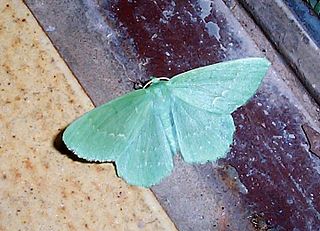
The Geometroidea are the superfamily of geometrid moths in the order Lepidoptera. It includes the families Geometridae, Uraniidae, Epicopeiidae, Sematuridae, and Pseudobistonidae. The Geomeatroidia superfamily has more than 24,000 described species, making them one of the largest superfamilies inside the order Lepidoptera. The monotypic genus Apoprogones was considered a separate geometroid family of the Apoprogonidae by a minority, but is now subsumed under the Sematuridae.

The Macariini are a tribe of geometer moths in the subfamily Ennominae. Though they share many traits with the Sterrhinae, this is probably plesiomorphic rather than indicative of a close relationship, and DNA sequence data points to the Boarmiini as particularly close relatives of the Macariini. All things considered, this tribe might still resemble the first Ennominae more than any other living lineage in the subfamily.

Ennominae is the largest subfamily of the geometer moth family (Geometridae) with some 9,700 described species in 1,100 genera. Most species are fairly small, though some grow to be considerably large. This subfamily has a global distribution. It includes some species that are notorious defoliating pests. The subfamily was first described by Philogène Auguste Joseph Duponchel in 1845.

The Bistonini are a tribe of geometer moths in subfamily Ennominae. As numerous ennomine genera have not yet been assigned to a tribe, the genus list is preliminary. In addition, the entire tribe is sometimes merged into a much-expanded Boarmiini. In other treatments, the Erannini are included in the present group.
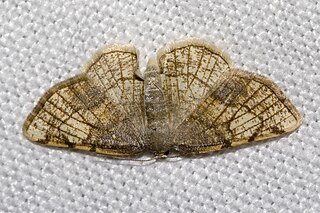
The Abraxini are a tribe of geometer moths in the subfamily Ennominae. Here, the Cassymini are considered a specialized offshoot of the Abraxini and merged therein; some authors consider them a distinct tribe however.

Geometrinae is the nominate subfamily of the geometer moth family (Geometridae). It is strongly split, containing a considerable number of tribes of which most are presently very small or monotypic. These small moths are often a light bluish green, leading to the common name of emerald moths, though a few species called thus are also found in the tribe Campaeini of the Ennominae. In 2018, a phylogeny and classification based on a molecular phylogenetic analysis was published in the Zoological Journal of the Linnean Society in which 13 tribes were accepted.
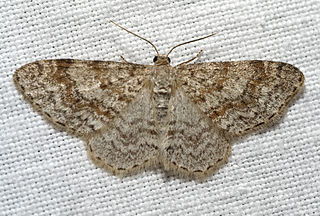
Larentiinae is a subfamily of moths containing roughly 5,800 species that occur mostly in the temperate regions of the world. They are generally considered a subfamily of the geometer moth family (Geometridae) and are divided into a few large or good-sized tribes, and numerous very small or even monotypic ones which might not always be valid. Well-known members are the "pug moths" of the Eupitheciini and the "carpets", mainly of the Cidariini and Xanthorhoini. The subfamily was described by Philogène Auguste Joseph Duponchel in 1845.

Perizoma alchemillata, the small rivulet, is a moth of the genus Perizoma in the family Geometridae. The species was first described by Carl Linnaeus in his 1758 10th edition of Systema Naturae.

Scopula immorata, the Lewes wave, is a moth of the family Geometridae. It is found throughout Europe and the Near East.

Eupithecia simpliciata, the plain pug, is a moth of the family Geometridae. It is found in the Palearctic realm, from western Europe to north-western China (Xinjiang). The species primarily colonizes wastelands, rubble and abandoned vineyards, and in Asia also salt steppes. In the Alps, the range of altitude extends up to 1200 metres.
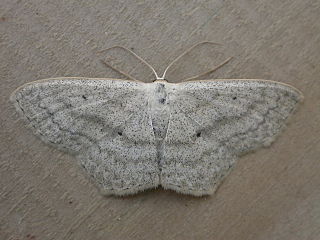
Scopula nigropunctata, the sub-angled wave, is a moth of the family Geometridae. It is found through most of the Palearctic realm.

Eois is a genus of moths in the family Geometridae. The genus contains about 250 validly described species, most from the Neotropical region. Many species are still undescribed and the total number of species is estimated to be over a 1,000 in the Neotropical region alone. The genus was first described by Jacob Hübner in 1818.
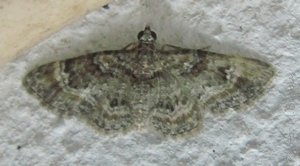
Gymnoscelis, the pugs, is a large genus of moths in the family Geometridae described by Paul Mabille in 1868.

Sterrhinae is a large subfamily of geometer moths with some 3,000 described species, with more than half belonging to the taxonomically difficult, very diverse genera, Idaea and Scopula. This subfamily was described by Edward Meyrick in 1892. They are the most diverse in the tropics with the number of species decreasing with increasing latitude and elevation.

Asthenini is a tribe of geometer moths under subfamily Larentiinae first described by Warren in 1893. The tribe has been combined with Eupitheciini in the past, most notably by Jeremy Daniel Holloway in his work The Moths of Borneo.
William Warren was an English entomologist who specialised in Lepidoptera.
Girida sporadica is a moth in the family Geometridae. It is found in eastern Africa, where it has been recorded from Ethiopia, Kenya, Rwanda, Uganda, Zimbabwe and Madagascar.
















